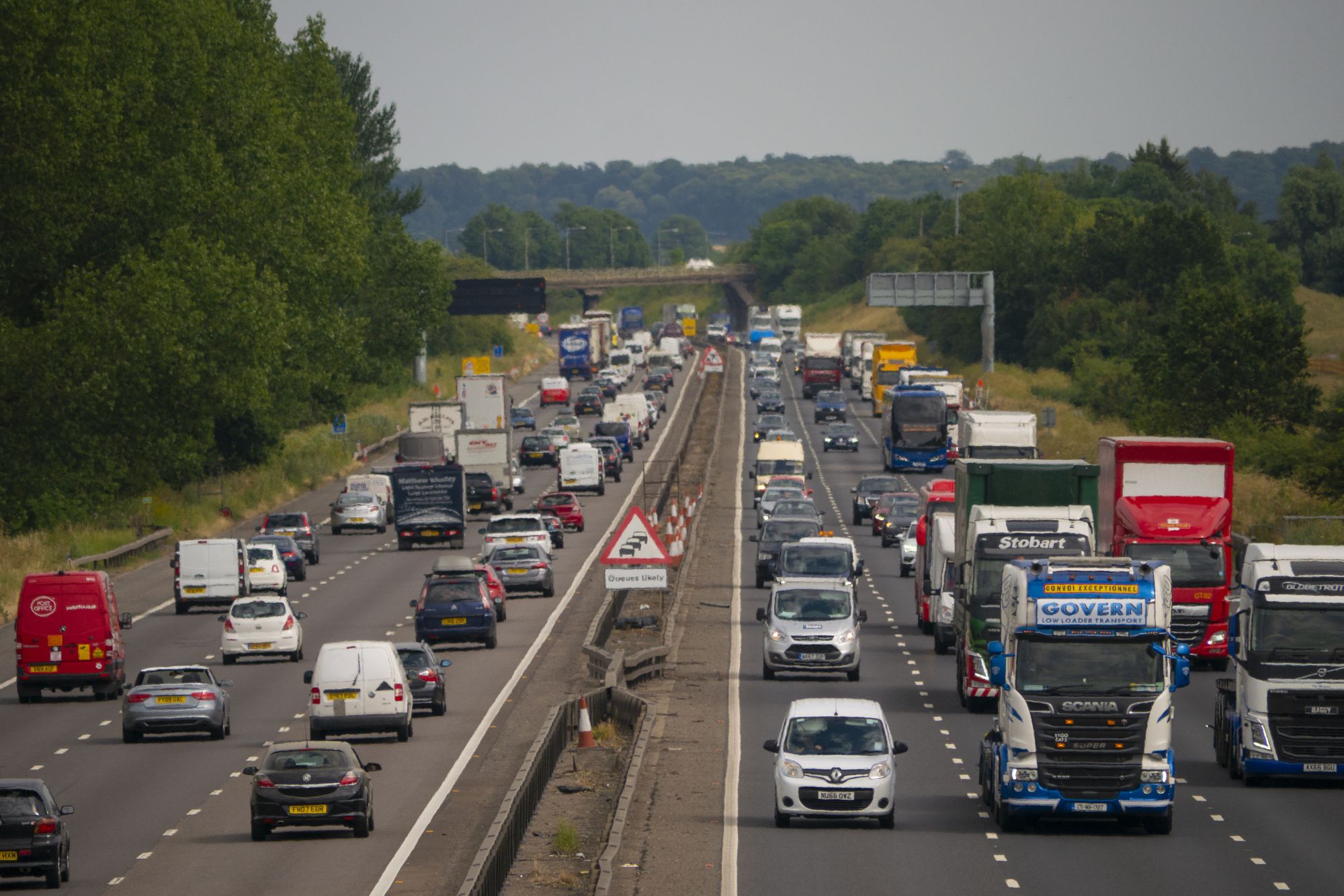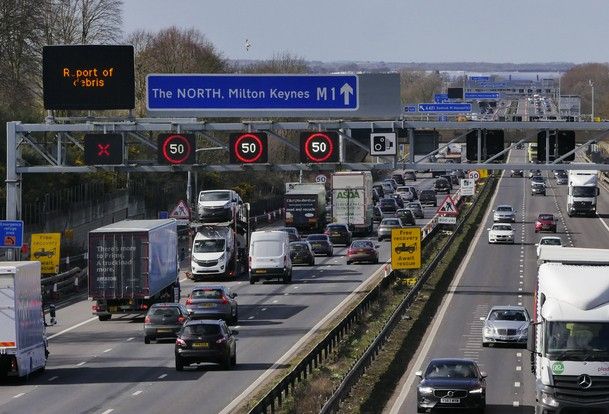Motorway Driving

Motorway Driving
Motorways are the road of choice for many when traveling on long distances but if you have never driven on one before then they can possibly seem a scary place. Until 2018 learner drivers were not allowed on the motorway as part of their driving lessons, the law was changed in June 2018 to allow learner drivers to have motorway driving lessons before passing their practical test but on the condition that your accompanying driver is a fully qualified ADI, you are not allowed on the motorway as a learner driver with anyone else.
Driving on a motorway can take a lot of concentration so its best to avoid them if your feeling tired or unwell. Research suggets that fatigue accounts for 15-20% of incidents on monotonous roads road such as motorways.
Joining a Motorway
There are two possible ways you can join a motorway. The main road you are traveling on can become a motorway, this will be indicated by signage. The other way is by using a slip road.
At the entry point where the slip road leads to the motorway, adjust your speed to that of the traffic already on the motorway before joining it. Give priority to traffic already on the motorway. Join the motorway where there is a sutiable gap in the left hand lane. Use your Mirror - Signal - Position - Speed - Look (MSPSL) routine. A quick sideways glance might be neccesary to verify the position of other vehicles. Try to avoid stopping at the end of the slip road unless queuing to join other slow moving traffic.
Make sure you do not force your way into the traffic already on the motorway and you must not drive along the hard shoulder. Once you have joined the motorway keep in the left hand lane until you have adjusted your speed to the traffic already on the motorway.
Driving on the Motorway
While driving on the motorway you should stay in the left hand driving lane next to the hard shoulder unless overtaking other slower moving vehicles or moving to allow other vehicles to join the motorway. It is important that you maintain effective observation directly ahead of you as well as behind. You need to keep your eyes moving between your mirrors and the road ahead, you need to anticipate what other vehicles are doing or likely to do. At high speeds situations can change rapidly and effective observation will you prepare for any sudden developments. Try an avoid sudden braking, try and anticapate problems early so you can take early action before the problems develop.
Make sure you keep a safe distance from the vehicle in front to allow for the increased speeds. You should leave a gap of one metre for every mph of your speed. Dont forget to double this distance if bad weather or the road is wet. In icy conditions you will need to leave up to 10 times the distance.
Tailgating is very dangerous and is the main cause of many accidents on the motorway. If you find someone is tailgaiting you please dont let them panic you, the best thing to do if your not already in the left hand lane is to move over to the left hand lane as soon as its safe to do so, you can also increase your gap in front of you to allow you more time to slow down if needed. If the vechle in front of you is going slower than you, please dont be tempted to tailgate them, be patient and allow them to move back into the left hand lane in their own time.
When changing lanes on a motorway makesure you use your MSM routine in plenty of time and make sure your signal is on in plenty of time before you change lanes, remember not everybody sticks to the speed limit so make sure you know what other vehicles are doing before you put on your signal. If changing from lane one to lane two make sure you are aware of any vehicles that might be in lane three as they could change to lane two as well.
Leaving a Motorway
Unless you're going to the end of the motorway, you'll leave my moving left from the left hand lane into a slip road, Position yourself in the left hand lane in plenty of time. The distance to the exit will start with a sign one mile from the exit, followed my half of a mile and then 300 yards, 200 yeards and 100 yards.
You should plan to be in the left hand lane ready to leave no later than the half mile marker, at 300 yards you should start your MSM routine ready to move onto the slip road.
Stopping on Motorways
You must only stop on a motorway if
- red lights or other signs or signals tell you to do so,
- your asked to stop by the police,
- Its an emergency,
- if it will prevent an incident
You must not stop on a motorway or the slip road to set down or pick up anyone.
Reflective Studs
These will help you determine the road layout.
- Red - between hard shoulder and carriageway.
- White - between lanes.
- Amber - between edge of carriageway and central reservation.
- Green - between carriageway and slip road exit and entrances.
- Fluorescent green/yellow - at contraflow systems and road works.
What to do in case of breakdown
- Drive to the next junction or the nearest services if possible. If you can't, indicate left and pull on to the hard shoulder calmly and smoothly.
- If you have to slow down quickly, put your hazard warning lights on and carefully move to the left when the lane is clear.
- Come to a smooth stop, ensuring you’re as far over to the left of the hard shoulder as possible. Turn your wheels away from the motorway, too, just in case the car rolls.
- Turn the car’s hazard warning lights on.
- Don’t put a warning triangle behind the car. In fact, spend as little time on the hard shoulder as you can – and never attempt to repair your car on the hard shoulder.
- Always get out of the car through the left-hand doors – never attempt to exit on the driver’s side.
- Leave animals inside the car; it’s safer for them and other road users if they’re left inside.
- Call a breakdown recovery service, or if you are unable to use a mobile phone, walk to the nearest emergency phone, which will be indicated by arrows on the bollards at the edge of the Tarmac. Its important that you and your passengers wait for assistance behind the Armco crash barrier.
- Remember, the hard shoulder is only for breakdowns and emergencies, and is a dangerous place to be, given the speed of the vehicles travelling on the motorway.
Motorway speed limits
- Cars and motorcycles (including car-derived vans up to 2 tonnes max laden weight) can drive at a maximum speed of 70 mph on the motorway.
- Vehicles towing caravans or trailers inc cars, motorcycles, goods vehicles up to 7.5 tonnes MLW can drive at a maximum speed of 60 mph on the motorway
- Buses, coaches, minibuses up to 12 metres (39 ft) Goods vehicles up to 7.5 tonnes MLW can drive at a maximum speed of 70 mph on the motorway unless towing a trailer
- Goods vehicles over 7.5 tonnes MLW can drive a maximum speed of 60 mph on the motorway
Towing on a motorway
If you have have a catagory B driving licence then you are allowed to tow a trailer no more than 750kg, if you are towing a trailer of any size or weight on the motorway then your maximum speed limit will be 60 mph. You will also be restricted to the first two lanes only, you are not allowed to use lane three or four if you are towing a trailer of any size. If you wish to tow a larger trailer using your car then please see our towing page for more details

Smart Motorways
Many parts of Highways England’s motorway network use technology to monitor and manage the flow of traffic. The technology is controlled from regional control centres which can activate and change signs and variable speed limits. This helps keep the traffic flowing more smoothly.
This map shows routes of completed smart motorways and smart motorways under construction.
The three types of motorway shown on the map are:
- Dynamic hard shoulder: where the hard shoulder is temporarily opened up to traffic
- All lane running: where the full width of the road is usable with emergency refuge areas alongside
- Controlled motorway: with three or more lanes, a hard shoulder and variable speed limits
On some busier sections of motorways we temporarily open the hard shoulder or have converted it to a permanent extra lane so that more vehicles can travel, avoiding the expense and disruption of widening the road.
These technology-enabled sections of motorways have enhancements such as:
- electronic message signs that display Red X signs and variable speed limits
- sensors to monitor traffic volumes
- CCTV cameras
- emergency areas, with emergency roadside telephones
- Never drive in a lane closed by a Red X.
- Keep to the speed limits shown on the signs.
- A hard shoulder is always identified by a solid white unbroken line - if there’s no speed limit displayed above it or a Red X is displayed, do not use it except in emergency.
- A broken white line indicates a normal running lane.
- If the hard shoulder is being used as an extra lane, use the designated emergency areas for emergencies.
- If your vehicle experiences difficulties, eg warning light, exit the motorway immediately, if you can.
- If you break down, put your hazard lights on.
- Most breakdowns are preventable - keep your car well maintained, check your tyres and make sure you have enough fuel for your journey.
Breaking down on a smart motorway
Knowing what to do in an emergency or a breakdown is key to keeping yourself and others safe.
If your vehicle has a problem on a motorway with no hard shoulder:
- Move into the left hand lane and put your hazard lights on
- Exit at the next junction or services OR
- Follow the orange SOS signs to an emergency area and call for help using the free telephone. This will tell us your location.
If you can’t get off the motorway or to an emergency area:
- Move your vehicle as close as possible to the left-hand verge, boundary or slip road
- If you feel you can get out safely with any occupants, consider exiting your vehicle via the left-hand door, and wait behind the safety barrier if there is one and it is safe to do so. Keep clear of your vehicle and moving traffic at all times
- Call 999 immediately
If your car stops unexpectedly in any lane and it is not safe to get out
- Keep your seatbelts and hazard lights on and call 999 immediately
- We’ll close the lane and send help.
If there is a hard shoulder on a motorway, you can use it to stop in an emergency only. If you can, get behind the safety barrier and away from your vehicle and moving traffic. Use the free SOS phone or call Highways England on 0300 123 5000 for help. Why not save the number in your phone now in case you ever need it?
Do not put out a warning triangle in any circumstances.
All motorists should be able to make their own recovery arrangements in the event of a breakdown. We advise you to carry details of your provider with you.
Remember, most breakdowns are avoidable and simple vehicle checks can help you have a safer journey. Check your tyres, fuel, oil and water. However, if your vehicle appears to have problems or is damaged, always try to exit the motorway.
Control centres
Our regional control centres use CCTV cameras to monitor and manage our motorways. Once they’re aware of your situation (via CCTV or the police), they can set overhead signs and close the lane to help keep traffic away from you.
The control centre can also send a traffic officer or the police to help you, and assist you to rejoin the motorway when appropriate.
Please note that if you break down or are in an emergency, you must call for help as soon as possible.

